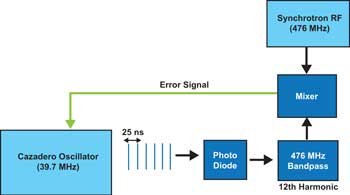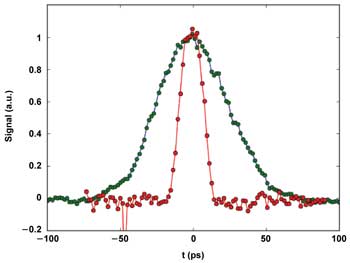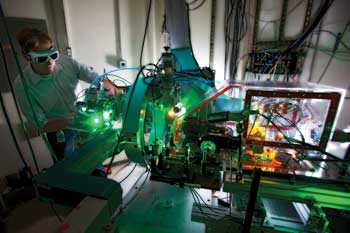Dr. Tony Lin, Calmar Laser, Inc.
Although ultrafast fiber laser technology is perhaps the catalyst that will finally allow the nascent industrial ultrafast laser market to reach its full potential, researchers also are embracing this technology for cutting-edge science.
The growth of optical fiber technology is not restricted to the industrial laser manufacturing sector: The diversity of fiber laser applications goes way beyond cutting, welding and materials processing applications. The intrinsic robust architecture and low maintenance of fiber-based architectures – coupled with exceptional performance parameters such as ultrashort pulse widths, higher pulse energies, flexible repetition rates, broader wavelength coverage and phase locking – are extending the capabilities of multiuser light source facilities to enable innovative research studies.
Over the past several years, fiber lasers have made increasing inroads into the market and now account for more than 10 percent of the overall nondiode laser segment. Although most of the market penetration has been confined to the industrial manufacturing sector, the advantages of fiber lasers in terms of turnkey reliability, intrinsic stability and predictable operation in a relatively small footprint appeal to a much wider customer base.
And further market growth is likely, through both new applications and market share erosion of conventional lasers. Researchers also are embracing ultrafast fiber laser technology at multiuser facilities such as SLAC National Accelerator Laboratory in Stanford and Lawrence Berkeley National Laboratory (LBNL) in Berkeley, both in California.
Advances in synchrotron and free-electron lasers (FELs) are providing researchers with access to ever-brighter and -shorter x-ray sources. For many years, Stanford Synchrotron Radiation Lightsource (SSRL) has provided pulses of x-rays for investigating the molecular and crystallographic structure of materials. More recently, the development of a “low-alpha mode” has allowed access to x-ray pulses of 1-ps duration.
Meanwhile, the Linac Coherent Light Source (LCLS) at SLAC is delivering sub-100-fs pulses with ~1012 x-ray photons at wavelengths as short as 0.15 nm. These ultrafast hard x-ray pulses, with both high spatial and temporal coherence, are enabling the investigation of new fields of science, from 3-D imaging and dynamical studies of important biomolecules to characterizing transient states of matter.
In a synchrotron or FEL, energy is extracted from an electron beam that passes through an undulating magnetic field. The path of the electrons is bent back and forth by an array of magnets of alternating polarity, causing a release of energy in the form of light. In the case of a synchrotron, the radiation is spatially incoherent with typical pulse durations on the order of 100 ps, whereas FELs emit an intense, spatially coherent output beam with pulses as short as tens of femtoseconds. To support operation at hard x-ray wavelengths, the electrons must be tightly bunched so that they interact coherently with the released light (effectively achieving self-amplified stimulated emission).
Because an FEL has no resonator and is a single-pass device, an extremely bright electron beam is required to achieve gain saturation. This is sometimes accomplished by using a conventional ultrafast laser source (such as Nd:YLF or Ti:sapphire) to excite a photocathode in an accelerating radio frequency (RF) field to serve as an electron injector. Synchronization is achieved by locking the ultrafast laser to a master clock that also is controlling the Linac.

Figure 1. Schematic/block diagram of the synchronization scheme.
In addition, for a number of synchrotrons around the world, time-resolved beam lines have been developed using conventional ultrafast sources to enable pump-probe studies. For each of these configurations, however, a major drawback has been that conventional solid-state ultrafast amplifiers typically consume an enormous optical table and require daily maintenance to ensure optimum performance.
Professor Aaron Lindenberg of Stanford University overcame this problem at SSRL by using a turnkey ultrafast fiber laser, the Cazadero from Calmar Laser. Designed for demanding OEM medical and microelectronics processing applications, the laser’s compact size and simple setup facilitate convenient installation and relocation from one experimental beam line to another. Furthermore, its high pulse energy (up to 20 µJ at <500 fs) and high repetition rate play to the strengths of the SSRL, enabling time-resolved studies with an excellent signal-to-noise ratio.

Figure 2. Pulse width of synchrotron from cross-correlation signal.
In Lindenberg’s initial experiments, the ultrafast fiber laser, operating at a repetition rate of 1.28 MHz, has been successfully phase-locked to the synchrotron 476-MHz RF signal (Figure 1) with a timing jitter of less than 1 ps and used to directly measure the x-ray pulse duration. Figure 2 shows direct measurements of the synchrotron pulse in a short-pulse x-ray mode. The experiments are carried out by cross-correlating in a barium borate crystal visible light at 500 nm generated by the synchrotron with the laser’s phase-locked 1030-nm output and detecting the sum frequency-mixed signal at 340 nm. The shortest pulses recorded are ~3 ps in duration.
The synchronism of the optical and x-ray pulse enables a unique class of pump-probe experiments (Figure 3). The high-energy output pulse of the fiber laser system pumps or excites a sample, inducing a kind of physical or photochemical transformation. The change then is interrogated at the atomic level by an x-ray pulse from the synchrotron. By varying the arrival time of the probe pulse, the dynamics of the process can be followed as an “x-ray movie” of the structural changes occurring at the atomic level. The approach is being used to gain a better understanding of the excited-state dynamics of nanocrystalline systems and the way in which they differ from their corresponding bulk structures.

Figure 3. X-ray goniometer; at center, a sample is illuminated simultaneously by x-rays and second-harmonic light (515 nm) from the Cazadero laser system.
In a recent study, Lindenberg’s group used the laser source to photoexcite a system of nanocrystalline silver selenide (Ag2Se) and successfully used the x-rays to follow structural transformations occurring on ultrafast timescales. Although these initial studies are very encouraging, enhanced detector and sample delivery systems are now in development to further improve the signal-to-noise levels. Future studies are expected to provide insight for the development of unique catalysts and more efficient photovoltaic materials.
At LBNL, the Cazadero also has been chosen to enable the development of a light source called the Next Generation Light Source (NGLS). In this case, the laser is again phase-locked but is used to irradiate a photocathode to produce “bunches” of electrons that are accelerated to high energy in an RF cavity. This system is being developed as the electron injector for the NGLS.
The NGLS is an FEL producing x-rays into the kilo-electron-volt energy range and will be unique in operating at a megahertz repetition rate. Depending on the choice of photocathode material, the laser will operate at its fundamental 1030-nm wavelength; its second harmonic, 515 nm; or its fourth harmonic, 257.5 nm.
“The choice of the photocathode laser system is critical in the design of a machine devoted to support a user facility,” said Dr. Howard Padmore, experimental group systems leader for the Advanced Light Source at Lawrence Berkeley. “We cannot tolerate any human intervention on a daily basis. The Cazadero is a unique system offering reproducible stable operation with a simple on/off switch. In addition, it provides all the key technical specifications such as power, repetition rate and pulse duration for different types of cathode as well as frequency locking.”
The NGLS high-repetition-rate, high-brightness x-ray source will enable cinematic imaging of dynamics, determination of the structure of heterogeneous systems and development of novel nonlinear x-ray spectroscopies.
Meet the author
Dr. Tony Lin is CEO at Calmar Laser Inc. in Sunnyvale, Calif.; email: [email protected].